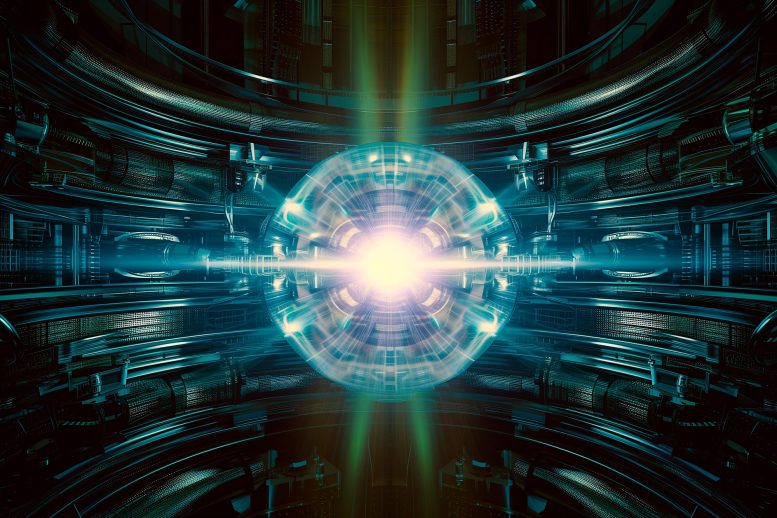
Novel Technique Extracts Uranium From Seawater for Nuclear Energy
-
by Anoop Singh
- 9

A new study reveals an efficient method for extracting uranium ions from seawater using a specially designed electrode material. This approach offers a sustainable alternative to traditional uranium mining, potentially turning the oceans into vast sources of nuclear fuel.
Most of the Earth’s surface is covered by oceans, which are teeming with a wide variety of life. Interestingly, these vast bodies of water also contain a dilute distribution of uranium ions. Extracting these ions could potentially offer a renewable source of fuel for nuclear power generation. A recent study in ACS Central Science introduces a new material designed for electrochemical extraction. This innovation is more effective at capturing the elusive uranium ions from seawater compared to previous techniques.
Nuclear power reactors release the energy naturally stored inside of an atom and turn it into heat and electricity by literally breaking the atom apart — a process known as fission. Uranium has become the favored element for this process as all its forms are unstable and radioactive, making it easy to split.
Currently, this metal is extracted from rocks, but uranium ore deposits are finite. Yet, the Nuclear Energy Agency estimates that 4.5 billion tons of uranium are floating around in our oceans as dissolved uranyl ions. This reserve is over 1,000 times more than what’s on land. Extracting these ions has proven to be challenging, though, as the materials for doing so don’t have enough surface area to trap ions effectively. So, Rui Zhao, Guangshan Zhu, and colleagues wanted to develop an electrode material with lots of microscopic nooks and crannies that could be used in the electrochemical capture of uranium ions from seawater.

This new coated cloth effectively accumulated uranium (in yellow) on its surface from uranium-spiked seawater. Credit: Adapted from ACS Central Science, 2023, DOI: 10.1021/acscentsci.3c01291
Innovative Electrode Material Development
To create their electrodes, the team began with flexible cloth woven from carbon fibers. They coated the cloth with two specialized monomers that were then polymerized. Next, they treated the cloth with hydroxylamine hydrochloride to add amidoxime groups to the polymers. The natural, porous structure of the cloth created many tiny pockets for the amidoxime to nestle in and easily trap the uranyl ions.
In experiments, the researchers placed the coated cloth as a cathode in either naturally sourced or uranium-spiked seawater, added a graphite anode, and ran a cyclic current between the electrodes. Over time, bright yellow, uranium-based precipitates accumulated on the cathode cloth.
In the tests using seawater collected from the Bohai Sea, the electrodes extracted 12.6 milligrams of uranium per gram of coated, active material over 24 days. The coated material’s capacity was higher than most of the other uranium-extracting materials tested by the team. Additionally, using electrochemistry to trap the ions was around three times faster than simply allowing them to naturally accumulate on the cloths. The researchers say that this work offers an effective method to capture uranium from seawater, which could open up the oceans as new suppliers of nuclear fuel.
Reference: “Self-Standing Porous Aromatic Framework Electrodes for Efficient Electrochemical Uranium Extraction” by Dingyang Chen, Yue Li, Xinyue Zhao, Minsi Shi, Xiaoyuan Shi, Rui Zhao and Guangshan Zhu, 13 December 2023, ACS Central Science.
DOI: 10.1021/acscentsci.3c01291
The authors acknowledge funding from the National Key R&D Program of China, the National Natural Science Foundation of China, the Project of Education Department of Jilin Province, the Natural Science Foundation of Department of Science and Technology of Jilin Province, the Fundamental Research Funds for the Central Universities, and the “111” project.
A new study reveals an efficient method for extracting uranium ions from seawater using a specially designed electrode material. This approach offers a sustainable alternative to traditional uranium mining, potentially turning the oceans into vast sources of nuclear fuel. Most of the Earth’s surface is covered by oceans, which are teeming with a wide variety…
A new study reveals an efficient method for extracting uranium ions from seawater using a specially designed electrode material. This approach offers a sustainable alternative to traditional uranium mining, potentially turning the oceans into vast sources of nuclear fuel. Most of the Earth’s surface is covered by oceans, which are teeming with a wide variety…
